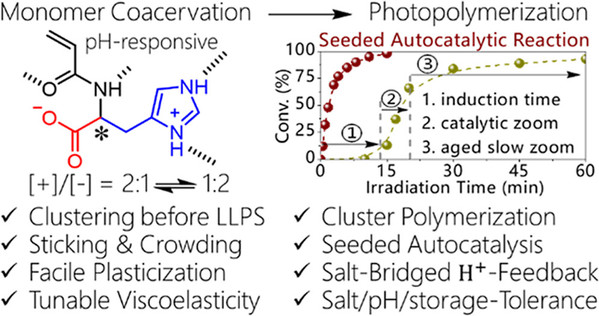Charge-Mediated Self-Coacervation of Zwitterionic Histidine Acrylamide That Leads to Viscoelasticity-Controlled Autocatalytic Polymerization
Xubo Fan1, Xiyu Wang1, Xiaoyue Xu1, Qing Zheng1, Xinhua Lu1, Yuanli Cai1(蔡远利)*
1State-Local Joint Engineering Laboratory for Novel Functional Polymer Materials, Suzhou Key Laboratory of Macromolecular Design and Precision Synthesis, Jiangsu Engineering Laboratory of Novel Functional Polymeric Materials, Jiangsu Key Laboratory of Advanced Functional Polymer Materials, College of Chemistry, Chemical Engineering and Materials Science, Soochow University, Suzhou 215123, China
Macromolecules 2025,58, 13, 6488
Abstract: We herein demonstrate charge-mediated self-coacervation of zwitterionic histidine acrylamide that leads to viscoelasticity-controlled autocatalytic polymerization under photo-RAFT conditions. This monomer assembles into well-defined ion clusters, followed by self-coacervation via liquid–liquid phase separation (LLPS), leading to fluid droplets (pH 2.5) and hardening droplets (pH 7.1). A RAFT chain transfer agent (CTA) acts as a sticker to promote droplet fusion and Ostwald ripening, leading to autocatalytic reactions involving the induction period, fast chain propagation, and kinetically trapped or aged slow reactions, in a monomer cluster polymerization manner, showing salt-bridged proton-feedback capable of acidification of the acidic reaction medium and alkalization of the neutral reaction medium. Hydrogen-bonded complexation of macro-CTA onto monomer coacervates leads to liquid–liquid core–shell droplet reactors at pH 2.5; monomer plasticization can improve coacervate fluidity, leading to a seeded autocatalytic polymerization up to >95% conversion in 11 min. The final ultrathin lamellae exhibit outstanding responsiveness and unprecedented colloidal stability against dilution, pH fluctuation, salting, and long-term storage. These findings highlight pivotal roles of orchestrated associative/repulsive charge interactions for LLPS-mode coacervation and provide a simple guideline to predict viscoelasticity-controlled autocatalytic polymerization with enzyme-like reaction efficacy.

Article information: https://pubs.acs.org/doi/10.1021/acs.macromol.5c01342